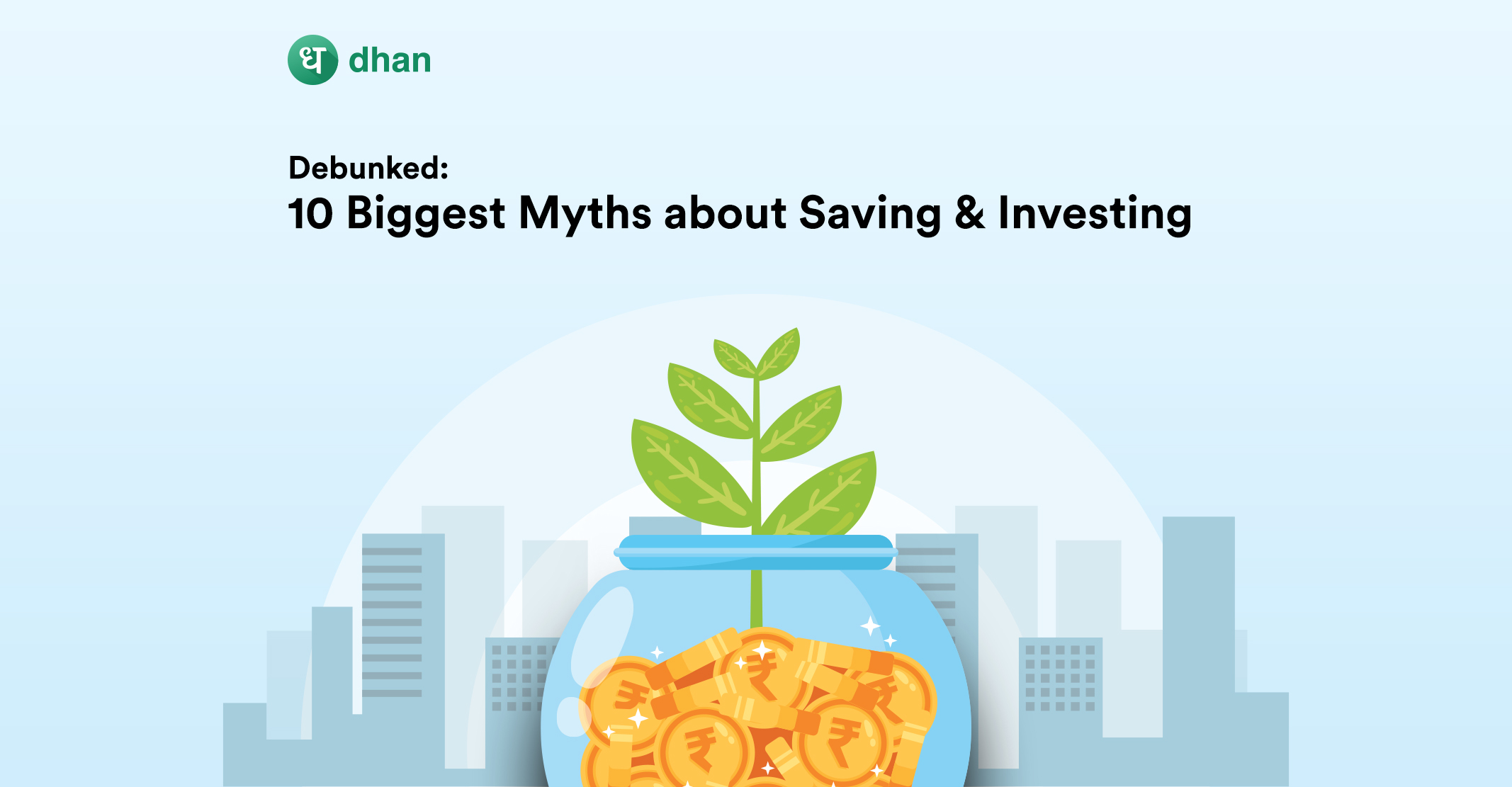If enough people repeat a myth, it becomes a fact. This adage is true, especially in saving and investing, where a lack of solid personal finance resources has led to many misconceptions.
These misconceptions have a reputation for crippling wealth creation en masse. Not anymore – we’re going to debunk 10 of these misconceptions, myths, and untruths about savings and investments.
Myth #1: Saving = Investing
It’s not uncommon for people to suggest that saving money and stashing it in a bank savings account is investing. That’s not true.
The reality is that saving money from your salary is an important exercise. But it may not be enough. Moreover, it definitely isn’t the same as investing in stocks, ETFs, mutual funds, and others.
The average bank savings account in India can give you 2% to 2.5% interest at best. Assets like stocks, ETFs, and mutual funds on the other hand are known to beat inflation comfortably.
| Type | Average Returns |
| Savings account | 2-2.5% |
| Stocks | 9-16% |
| ETFs | 8-10% |
| Mutual funds | 6-16% |
Thus, saving may not be enough to beat inflation, let alone create wealth for goals like financial freedom.
Myth #2: Investing is Only for the Wealthy
Investing is a concept many believe is reserved for the rich and wealthy. The myth becomes compelling when you take into account the median per capita income of India which is ~$5,000 (Rs. 3,97,822).
Most people don’t have enough money to invest while those who do are reeled in by myths and misconceptions about saving and investing.
This may explain why only 4% of India’s population or a little over 1 crore people actively invest in the stock market.
| Country | # of Equity Investors |
| USA | 19+ crores |
| China | 17+ Crores |
| India | 1+ Crores |
To debunk this myth, we’ll have to take a historical view of how saving and investing in India worked. Traditionally, the average Indian in the 20th century preferred to invest in bank fixed deposits and gold.
Who doesn’t love safety & lucrative returns? Fixed deposits and gold offered both. In fact, there was a time when FD interest rates were a whopping 13% in India back in the 1990s.
Gold, on the other hand, was preferred for its sentimental value. The belief was that it could stand the test of time as it could be passed down to future generations.
Stocks and other assets were reasonably volatile and were accessible to affluent investors who had the know-how and means to invest in them. But times have changed.
The truth is that online investment apps like Dhan have made it possible for anybody with a PAN card, stable internet connection, and smartphone to invest in various assets in India.
Myth #3: You Need a Lot of Money to Invest
Carrying on from the previous myth, it’s a general misconception that you need a lot of money to start investing in ETFs, stocks, mutual funds, and others. This is far from the truth.
While good investments do cost a premium, the money you need to begin investing is relatively low. You can start a daily, weekly, and monthly stock SIP on Dhan for a low amount.
Furthermore, Some mutual funds may allow you to start with as low as Rs. 500. Either way, you can visualize the power of compounding with these two calculators:
More than a lot of money, what investors need when investing is to remain patient and invest in quality rather than quantity based on what’s right.
At the end of the day, there’s an investment option out there for everyone but it is only wise to invest once you’ve thoroughly evaluated your risk profile and financial goals.
Myth #4: Investing in Stocks is Gambling
You may have heard this myth firsthand when conversing with friends and family. Because of the rampant price swings and mishaps in the 90s, many in India still believe that investing in stocks is similar to gambling.
Blots like the Harshad Mehta scam have left a sour taste in the Indian stock market while the dot-com bubble served as a bitter reminder of how innovations can turn to dust easily.
That said, the reality is far from this and many myths of the stock market. The Indian stock market of today is significantly different from the one that was around in the 1990s.
Bear in mind that India had just gone global at the time and was recovering from a crippling economic crisis. One could even say that the country was finding its way into the financial world.
Fast forward to today, there are laws, regulations, and governing bodies like SEBI in place to ensure that the needs of investors are looked after before anything else.
Furthermore, publicly-traded companies are always under the microscope. If the governing bodies get even a whiff of wrongdoing, it generally spells trouble for the company in question.
That’s not all. The growth of the Indian share market has been steady across the past three decades with periodic drops.
This is one of the reasons why stocks are known to be the best ways to make money in India, especially with proper regulations in place now.
To summarize, there is a method to the madness – one that relies on thorough research, diligent financial planning, and a deep evaluation of your risk profile. This brings us to the next myth.
Myth #5: Timing the Market is Important
Which approach do you think is likely to make more money in the stock market:
- Investing across market highs and lows
- Investing when a specific event happens (pandemic, market crash, etc)
The answer is, both (maybe). However, #1 is known to be far less stressful than #2 as you will have the chance to invest consistently when the markets rise and fall based on what works for you.
That is, without the stress of constantly monitoring the markets to find the right time to invest. There’s more.
Timing the market can be difficult even for the most seasoned investors because investor behavior may be irrational, economic conditions may be hot or cold, and markets themselves may be volatile.
Time in the market is the alternative to the myth that you need to time the market. You can read more about this phenomenon here: Do SIPs Generate Higher Returns Only During Market Correction?
Myth #6: There’s a “Right Age” for Saving and Investing
The longer you give money the chance to compound, the better the results can be. But that is not bad news for those who want to begin saving and investing at a later stage in life.
Truth is, it’s better to start investing as soon as possible than to dwell on the fact that you’ve begun late. This will give you the chance to generate potentially better returns than leaving your surplus cash idle.
Furthermore, not everyone’s life story is the same. Comparing your journey or questioning whether you should be investing in the first place may put a damper on the potential wealth that you may be able to create.
Let’s take an example to drive home the point. Say someone who was born in 1960 invested in Sensex when it was established in 1986. As of 2022, that person would’ve earned a whopping 9,564.40% returns.
On the flip side, let’s say someone born in 1990 started investing in Sensex in 2009. They would’ve earned 509.17% returns by 2022. In either case, the investor would have made money and beaten inflation.
The investor who was born in 1990 can not create wealth by questioning why they weren’t born sooner. The only way to create wealth is to start investing, regardless of age or time.
Myth #7: Term Insurance is an Investment
An investment is an asset that earns you returns. Moreover, you can plan your investments such that they’re liquid and can be redeemed in parts or as a whole when necessary.
Term insurance does not check any of these boxes. For starters, it is not designed to generate returns or have liquidity. Term insurance is meant to create wealth for the policyholder’s family.
Furthermore, investments are made by identifying factors like:
- Risk profile
- Financial goals
- Affordability
A term insurance plan is crafted by establishing your life’s worth based on factors like:
- Age
- Health
- Present & future finances
- Present & future expenses
- Inflation
The confusion or myth, in this case, may be due to hybrid assets like ULIPs that try to provide protection and generate returns. The ironic part is that most ULIPs are known to fail in achieving both.
At the end of the day, a term insurance plan is a service that you pay for. Thus, it’s useful to treat term insurance as protection for you and your family rather than an investment.
Myth #8: It’s Too Early to Start Saving for Retirement
A working professional in their 20s and 30s may feel like retirement is a lifetime away. Their investment approach may also reflect this. The harsh reality is that not everyone will have the luxury of a pension.
The sooner you start financial planning for your retirement, the better chance you have to fulfill your post-retirement needs with the returns your money has earned.
This may also put you on the path toward financial freedom before retirement.
Most young investors like to start small when investing for retirement and periodically increase the amount as they age. This is known to be far more useful than saving huge sums for retirement later on in life.
| Person | 20s | 30s | 40s | 50s | Total Corpus |
| Laurel | 3,60,000 | 12,00,000 | 30,00,000 | 60,00,000 | 1,05,60,000 |
| Hardy | – | – | 30,00,000 | 60,00,000 | 90,00,000 |
As you can see from the example above, Laurel has a bigger corpus for retirement than Hardy even though they both saved similar amounts later on in life. This is just savings, mind you.
Choosing the right investments, however small, can be useful. In fact, small investment ideas have the potential to generate lucrative long-term returns. Want to know more? Check out smallcase on Dhan!
Myth #9: Budgeting & Setting Goals are Not Necessary
How often do you encounter folks who want to invest but can’t get started as they don’t have a plan. Or, someone who invests but doesn’t have a plan and is thus haywire in their approach.
The reason behind this problem of personal financial planning is two-fold:
- A lack of or improper budgeting
- No financial goals
Unless you know what your money is working towards, you may not be able to select the best investments. The first step to fixing this is to draw up a budget.
A budget will help you identify the amount of money that you can save and invest without having to sacrifice your needs and wants. The 50-30-20 rule is one of the most popular budgeting rules out there.
Once you know how much money you can invest, you need to narrow down financial goals that are realistic, achievable, and actionable spread across:
- Short-term
- Medium-term
- Long-term
After that, it’s just a matter of picking the right investments based on your risk appetite. While we’re on the topic of the right investments, financial goals more or less dictate the investments you should choose.
For example, stocks are known to be suitable investments for the long term. Investing in stocks for your short-term goals would thus be sub-optimal.
Myth #10: You Don’t Need Tax Planning
Let’s be honest – taxes are confusing. So much so that most people may choose to avoid planning taxes. The myth thus becomes “I don’t need to plan taxes. It’s going to be deducted anyway.”
The truth is that efficient tax planning can help you save money and generate returns.
For example, investing in ELSS Funds, NSC, Tax Saving FDs, and others can help you reduce Rs 1.5 lakhs of your taxable income under Section 80C. You’ll have to invest the equivalent amount to get the benefit.
Furthermore, NPS can help you save Rs. 50,000 more under Section 80CCD (1B). But you’ll need to know these three factors before you start planning your taxes:
- Your tax slab
- Financial goals
- Tax saving investments
In India, there are 7 tax slabs under the new regime. We’ve listed them in the table below.
| Income (in Rs) | Tax |
| 0 to 2.5 lakhs | None |
| 2.5 lakhs to 3 lakhs | 5% |
| 3 lakhs to 5 lakhs | 5% |
| 5 lakhs to 7.5 lakhs | 10% |
| 7.5 lakhs to 10 lakhs | 15% |
| 10 lakhs to 12.50 lakhs | 20% |
| 12.5 lakhs to 15 lakhs | 25% |
| 15 lakhs | 30% |
Identifying which tax slab you fall under will be crucial because you’ll know exactly how much taxes you need to pay or save. This factor will tie into the next one which is setting financial goals.
Most tax-saving investments are known to be suitable long-term either due to a mandatory lock-in or by design. If you have long-term goals, then these investments may become the means to achieving them.
Along the way, you’ll also earn lucrative returns while saving on tax. Next up is to know which investments can help you save tax. We’ll cover the popular taxing saving investments here:
- ELSS funds
- Public Provident Fund (PPF)
- National Savings Certificate (NSC)
- Tax-saving FDs
- National Pension Scheme (NPS)
- Sukanya Samriddhi Yojana (SSY)
- Senior Citizen Saving Scheme (SCSS)
Some of these are known to be the best investments to make money along with saving taxes. However, it is useful to consult a trained financial professional for tax planning, savings, and investments.
Conclusion
Financial myths are known to stunt wealth creation by limiting the investment horizon a person can access. The pointers above may help you overcome barriers, untruths, and myths about saving and investing.
Know that it’s important to start investing in order to have a fair shot at beating inflation and achieving various financial goals. For more information on personal finance, read these blogs:
1. 5 Investment Decisions To Take In Your Early 30s
2. How to Achieve your Financial Goals by Investing Online?
3. Renting vs Buying – Buy or Rent a House in India?
FAQs
Q. Is it better to save or invest?
Saving and investing are two sides of the same coin. The former may not give you above-average returns but the latter has potential. Investing a part of your salary in stocks, etfs, mutual funds, and others may give you a better chance of beating inflation. Saving can give you access to liquidity that can be useful during a rainy day.
Q. What is the main reason to invest instead of saving?
A person who invests may have a better chance of beating inflation and earning lucrative returns than someone who deposits money in a bank savings account. Investing in assets like stocks and mutual funds means earning 7-12% returns while stashing cash in a bank savings account means earning 2-3%.
Q. Can I save and invest at the same time?
Yes, many save and invest at the same time by following budgeting rules. For example, a person who builds an emergency portfolio by allocating 5% of their funds to it may deposit the entire amount in a bank savings account.
Disclaimer: This blog is not to be construed as investment advice. Trading and investing in the securities market carries risk. Please do your own due diligence or consult a trained financial professional before investing.




Comments are closed.